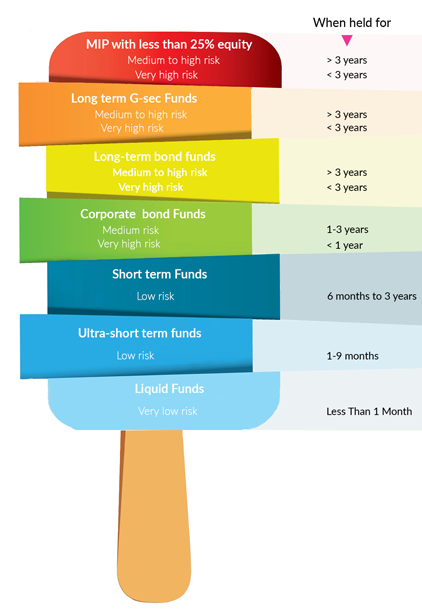
Liquid Fund – meant for short term holding, i.e. less than 3 months.
Liquid funds are debt mutual funds, that invest your money in very short-term market instruments such as treasury bills, government securities and call money, that hold least amount of risk. These funds can invest in instruments up to a maturity of 91 days. The maturity is mostly much lower than that.
Ultra-Short Term Fund- meant for short term holding, i.e. 3 to 12 months.
Ultra-shortterm fund is also suitable for short-term investing. But these are one notch higher on the risk chartcompared with liquid funds. This is because ultra-short-term funds can invest in short-term instruments that have a maturity of over three months. These instruments may also be traded in the market. Hence, the NAV may swing in response to market movements, making it a little more volatile.
Short Term Fund – meant for short term holding, i.e. 6 to 24 months.
A short-term fund, is a type of Mutual fund that invests in short-term investments of high quality and low risk. The goal of this type of fund is to protect capital with low-risk investments while achieving a return that beats a relevant benchmark such as a Treasury bill index.
Long Term Fund-meant for long term holding, i.e. greater than 24 months or 2 years.
These funds comprise of investments made in a basket of debt instruments of various maturities & issuers. These funds are suitable for investors who willing to take a relatively higher risk as compared to corporate bond funds,and have longer investment horizon. These funds tend to work when entry and exit are timed properly; investors can consider entering these funds when interest rates have moved up significantly to benefit from higher accrual and when the outlook is that interest rates would decrease. As interest rates go down, investors can potentially benefit from capital gains as well.
Gilt Fund-meant for holding, i.e. greater than 36 months or 3 years.
Gilt Funds invest in government securities of medium and long term maturities issued by central and state governments. These funds do not have the risk of default since the issuer of the instruments is the government. Net Asset Values (NAVs) of the schemes fluctuate due to change in interest rates and other economic factors. These funds have a high degree of interest rate risk, depending on their maturity profile. The higher the maturity profile of the instrument, higher the interest rate risk.
Fixed Maturity Plans (FMP) – meant for holding, i.e. greater than 36 months or 3 years.
Fixed Maturity Plans (FMPs)are closed ended Debt Mutual Funds that invest in debt instruments with a specific date of maturity that is less than or equal to the maturity date of the scheme. Securities are redeemed on or before maturity and proceeds are paid to the investors. FMPs are similar to passive debt funds, where the portfolio manager buys and holds the debt securities for the entire duration of the product. FMPs are a good option for conservative investors, as they do not carry any interest rate risk provided the investor stays invested until the maturity of the product. They are also a tax efficient investment option.
Corporate Bond Fund – meant for holding, i.e. for 12 to 36 months.
These funds invest predominantly in corporate bonds and debentures of varying maturities that offer relatively higher interest, and are exposed to higher volatility and credit risk. They seek to provide regular income and growth and are suitable for investors with a moderate risk appetite with a medium to long term investment horizon.
Monthly Income Plan (MIP) – meant for holding,i.e. greater than 36 months or 3 years.
Monthly Income Plans (MIPs),strive to offer the benefit of diversification across asset classes by investing a proportion of the portfolio in debt securities (70% to 95%) with a smaller allocation in equity securities (5 % to 30 %).As the correlation between prices of equity and debt is low, this product endeavours to give an investor returns that are relatively higher than debt market returns. MIPs can be classified as debt oriented hybrids that seek to; generate income from the debt securities, maximise the benefits of long term growth from equity securities and aim for periodic distribution of dividends.
Curated by Rohit Grover
